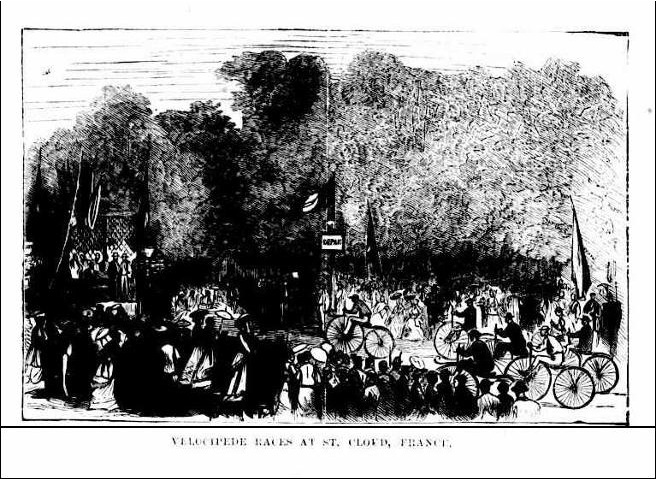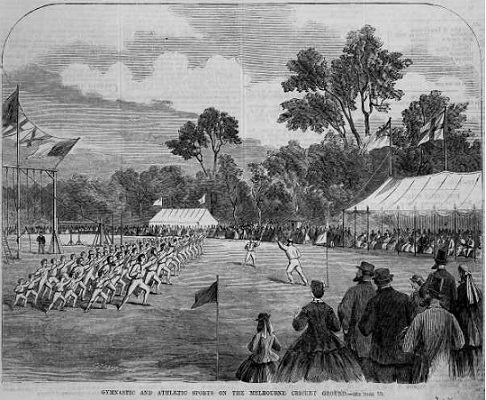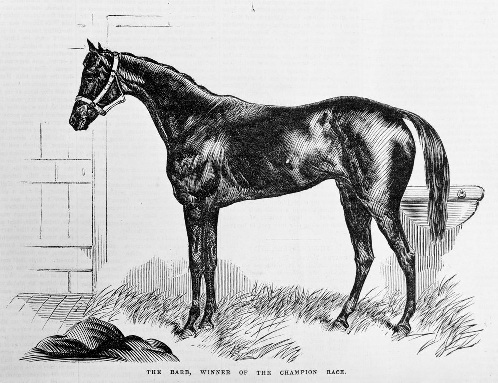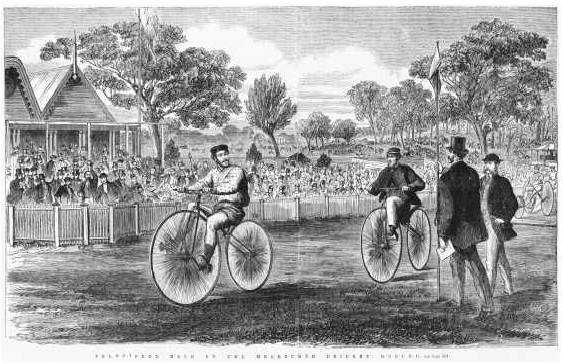James Finlay and the earliest known Victorian bicycle race:
James Finlay was the father of the three men who started Finlay Brothers. In 1869, he won a velocipede race on the Melbourne Cricket Ground riding a bicycle that he had built himself.
The following article gives a brief summary of some of the events of 1869:
It's early 1869...
Reports of the European and American two-wheeled velocipede craze are met with curiosity in Australia. Newspapers provide tantalising descriptions – but is this “bicycle” really a new vehicle… or just a passing source of mirth…?
“…the news was circulated that Paris had gone mad about velocipedes, and already the mania has spread through the greater part of the civilised world.”1 “…the latest Parisian and American, and may we add English, toy.”2
An amazing evolution of velocipede design was taking place. This vehicle had only two wheels and gained propulsion from pedals attached directly to the front wheel. No freewheeling was possible. The colloquial term “boneshaker” best described the rough ride of this vehicle’s hard metal wheels along cobblestone streets. “The first practical bicycle was called the velocipede by its makers and the “boneshaker” by the public.”3
 "Velocipede races at St. Cloud, France” published in an Australian newspaper in 1868
Source: Illustrated Sydney News22
Athletic Sports Meetings - consisting of mostly running races - were a regular event for the crowds of the young colonial Melbourne. In May 1869, the Melbourne Cricket Club announced that a velocipede race (both bicycles and tricycles) would be included in the program for their winter Athletic Sports Meeting on Thursday 1st July (Separation Day – a public holiday). The racing would be held at the Melbourne Cricket Ground (M.C.G).
“The committee have also offered a prize for the velocipede race of two miles, and the public will thus be enabled to form an idea of the rate of speed attained by this mode of locomotion, which has attained such popularity in Paris and London.”4 “Three velocipedes are to start, or no race.”5

“Gymnastic and athletic sports on the Melbourne Cricket Ground” 1866 by Samuel Calvert
Source: Pictures Collection, State Library of Victoria
A lot of the public knowledge of bicycles was probably gleaned from the snippets of information that were appearing in newspapers. However, in June 1869 the gaze of curious crowds began to focus on a 26 year old blacksmith – James Finlay – when he displayed a fascinating item of craftsmanship in an Elizabeth Street store.
“A bicycle velocipede – one of the few which have been manufactured in the colony – was on view yesterday at the shop of Messrs. McEwan and Co., Elizabeth Street. It was made by Mr. James Finlay, of Westgarth Street, Collingwood, who has constructed several other machines of a similar description. The maker has adopted as his model the machine most in use in New York, but he has made several modifications which he considers to be improvements on the American plan. The seat, for instance, which is placed midway between the front and second wheels, is made to rest on a steel spring, thus preventing the jolting which would otherwise be experienced in going over uneven ground. Then a new break has been applied, the merit of which is that the rider can stop his velocipede by simply leaning back in his seat. The bicycle is constructed on very simple principles, but it is somewhat difficult to manage at first on account of the skill required in balancing. The front wheel, which is employed both for driving and guiding, is turned by a couple of short cranks, moved by the feet, the driving power being thus directly applied… The specimen now being exhibited at Messrs. McEwan and Co.’s shop is of about the average size, the front wheel being thirty-three inches in diameter, and the back wheel twenty-eight inches. It has been made expressly for the race on the M.C.C. Ground on the 1st July…”6
James Finlay called his bicycle “The Barb”, in reference to the 1866 Melbourne Cup winning racehorse… “…a not inappropriate name if it fulfills the expectations of the maker.”7

“The Barb, winner of the champion race” 1867 Published by Robert Stewart
Source: Pictures Collection, State Library of Victoria
An evening display of bicycle riding, also in June 1869, helped to secure James Finlay’s status as favourite for the M.C.G. velocipede race. “The other bi-cycles in Mr. Finlay’s possession were tested last night in the presence of the committee of the Velocipede Club. The manufacturer drove several of them along Brunswick-street at the rate of from twelve to fifteen miles an hour, and appeared to manage them with the most perfect ease, turning them round in scarcely more than their own length. A very pretty looking tri-cycle, from Carlton, was brought into competition with the ‘bi-cycle, but the latter was found to possess nearly double the speed of the three-wheeled machine. Mr. Finlay seems to have been very successful in his novel manufacture, but he will soon have to contend against the imported French bi-cycles, a number of which are on their way to the colony.”8
Unfortunately, rainy conditions forced a postponement of the first date set for the M.C.G. races. The event was rescheduled for Saturday 10 July 1869, with the prize money increased in order to persuade country competitors to remain in Melbourne for the event. “With a view to stimulating the velocipedists to exertions, the Club have offered a substantial sum of £20 for 1st prize and for 2nd £5.”9
On the day of the postponement, a fiery conversation was recorded between James Finlay and a fellow competitor: “The velocipede belonging to Mr Ivey, of Ballarat, is also a very neat and light concern, and is much fancied by its owner, who got into a rather warm dispute with Mr Finlay as to the relative merits of the two machines, The Barb and the Ballarat. Mr Ivey, having expressed himself in very contemptuous terms as to the merits of the Fitzroy machine, Mr Finlay then and there offered to make a match for 20 pounds to run his velocipede against the Ballarat, giving it a furlong start in the mile. The invitation was, however, declined.”10
Anticipation grew as the new date for the racing neared. James Finlay’s riding prowess was recorded frequently in newspapers. “The impression on the ground was, that those who wish to have a chance to win the prize at the Melbourne Club Races must practice well to be able to come near Mr Finlay.”11
“Besides showing to what speed they could be driven – about twelve miles per hour – Mr. Finlay also showed how easily, with practice they could be turned. He described a circle several times of not more than 8ft. in diameter. That most difficult of feats – the balancing the machine whilst going slowly…”12
Large crowd numbers headed for the M.C.G. as the day of the racing arrived. “The Athletic Sports Meeting of the Melbourne Cricket Club, held on Saturday afternoon, passed off very successfully in the presence of over ten thousand persons attracted by the novelty of the velocipede races…”13 “…as soon as convenient after the business-hours of the day, troops of people wended their way from all parts in the direction of the ground.”14
The velocipede racing was to be contested by a field of twenty nine velocipedes, of which sixteen were bicycles, and the rest tricycles. However, less than half the number of bicycles entered actually started in the heats, giving the crowd cause for concern. “With bicycles there was a little more interest, but when only three vehicles appeared in the first heat, and a similar number for the second, some little disappointment was felt…R. Warnock, of Sinclair’s Iron Foundry, Yarra Bank, who worked his two wheeler very easily, won the first heat easily, and J. Finlay, on The Barb, secured a very complete victory over his two opponents in the second heat.”15
As the heats for the velocipede races progressed, it became apparent that few of the riders were skilled in velocipede riding, or capable of demonstrating the proficiency that the large crowds had perhaps been hoping for. “…the velocipede races, which, however, did not quite come up to expectation. Only three ran at all satisfactorily – Mr. Finlay’s Barb, Mr. Ivey’s Ballarat, and Mr. Warnock’s Emerald-hill, all bicycles.”16
The final of the velocipede race was to be run over two miles, with the first and second placegetters of each heat to compete. This meant that Finlay, Ivey and Warnock would also be racing against four tricycles. The large Melbourne crowd readied themselves for the contest. “This was the best velocipede race of the day, and afforded a fair opportunity of judging of the relative merits of the two and three wheeled machines. Thomson went off with the lead, but Finlay, who had stayed behind in order to get the inner side, soon showed to the front, bowling along in splendid style, fairly walking away from all competitors. The second time past the post Ivey got in front of a tricycle, which fouled, breaking off one of his treddles. He was thus disabled, and had to retire. The race then lay between Warnock and Finlay. Some of the tricycles gave up the contest as hopeless, and the remainder, after being overlapped on the course by Finlay, all retired excepting Thomson, who persevered for third place. Finlay had by now gained so strong a lead that the interest of the race lay in the probability of his overtaking Warnock, which he shortly did, amid loud cheers, his bicycle making nearly two revolutions to the one of his opponent, and he won easily, with more than the length of the course to spare – having accomplished the two miles in 11min. 29 1/2sec.”17
 "Velocipede race on the Melbourne Cricket Ground” 1869 by Samuel Calvert
Source: Pictures Collection, State Library of Victoria This lithograph shows James Finlay at the finishing line of the velocipede race.
This race has been recorded widely as the earliest known bicycle race in Victoria - and possibly the earliest in Australia. However, this has been a subject of conjecture over the ensuing decades. “…the first velocipede race ever held in the colony…”18
Following his celebrated win, James Finlay was notable in launching a widespread interstate newspaper advertising campaign. Of interest, he employed a manager to handle sales enquiries. “BICYCLES, BICYCLES, VELOCIPEDES, VELOCIPEDES. The only properly constructed BICYCLES to be seen in the Australian Colonies are those manufactured by JAMES FINLAY. Finished in a first class style, with all the latest American improvements, weight 40lbs., price TEN GUINEAS. Communications addressed to the Manager, F. MILLER, 76 Kerr-street, Fitzroy, Melbourne, will be promptly attended to. See Argus, Age, or Daily Telegraph of 22 June 1869.”19
A velocipede riding school was also publicised by James Finlay, though this appears to have been only a short term venture following his race win. “A velocipede school has been opened by Mr. Finlay, who has taken a lease of the Gratton-street Orderly-room, Carlton, and on Saturday evening there was an exhibition of skill in the management of the ticklish vehicles which are just now the rage. Mr Finlay and his brother, with some of the more advanced pupils, careered round the room with great speed, and improvised a sort of tournament with pine staves – the competitors running a tilt and attempting to unseat one another – but considerable skill was displayed by the combatants in avoiding the attacks of their antagonists. …The two younger sons of his Excellency received their first lesson on Saturday afternoon, at the private class, and took a bicycle home to practice on.”20
James Finlay seems to have returned to blacksmithing as his predominant occupation within a few years of the race at the M.C.G. However, his great bicycle “The Barb” appeared again in the newspapers of 1871 during a race report for an Athletic Sports Meeting on the M.C.G. in April 1871. “The prize was carried off by S. Brooks, who rode “The Barb”, the velocipede with which Finlay achieved such an easy victory in the first bicycle race run on this ground.”21
James Finlay lived in Melbourne until his death in 1922. In that time, he saw the establishment of the Finlay Brothers business by three of his sons – Charlie, Albert (Snr) and Bob. Perhaps this was a fitting continuation of the cycling passion that James Finlay found himself so publicly leading in the pioneering days of 1869…
 Goddard23 Goddard23
© 2011-2015 This article remains the property of the website administrators.
References: 1. “Velocipedes” (from the Evening Journal), South Australian Register (Adelaide S.A.: 1839-1900), May 31, 1869, 3. http://nla.gov.au/nla.news-article41398078 2. “Velocipede race on the M.C.C. ground”, The Australasian (Microfilm), June 12, 1869, 748. 3. Hugh Sharp, “From boneshaker to bicycle”, The Argus (Melbourne, Vic.: 1848-1956), December 6, 1930, 4 Supplement. http://nla.gov.au/nla.news-article4232260 4. The Argus (Melbourne, Vic.: 1848-1956), May 20, 1869, 5. http://nla.gov.au/nla.news-article5831829 5. The Argus (Melbourne, Vic.: 1848-1956), May 22, 1869, 5. http://nla.gov.au/nla.news-article5834324 6. The Argus (Melbourne, Vic.: 1848-1956), June 22, 1869, 5. http://nla.gov.au/nla.news-article5832508 7. Ibid. 8. Ibid. 9. “Athletic sports”, The Leader (Microfilm), July 10, 1869, 10. 10. “Athletic sports”, The Leader (Microfilm), July 3, 1869, 10. 11. “The velocipede mania”, The Mercury (Hobart, Tas.: 1860-1954), July 1, 1869, 3. http://nla.gov.au/nla.news-article8859900 12. See note 11 above. 13. The Argus (Melbourne, Vic.: 1848-1956), July 12, 1869, 5. http://nla.gov.au/nla.news-article5821023 14. “The sports on the M.C.C. ground. The velocipede race” (abridged from the Telegraph), The Mercury (Hobart, Tas.: 1860-1954), July 17, 1869, 3. http://nla.gov.au/nla.news-article8860198 15. Ibid. 16. The Argus (Melbourne, Vic.: 1848-1956), July 12, 1869, 5. http://nla.gov.au/nla.news-article5821023 17. “Athletic sports on the Melbourne Cricket Ground”, The Argus (Melbourne, Vic.: 1848-1956), July 12, 1869, 6. http://nla.gov.au/nla.news-article5821039 18. The Australasian cited in The Brisbane Courier (QLD.: 1864-1933), July 9, 1869, 2. http://nla.gov.au/nla.news-article1290345 19. “Advertising”, The Mercury (Hobart, Tas.: 1860-1954), July 13, 1869, 1. http://nla.gov.au/nla.news-article8860112 20. The Argus (Melbourne, Vic.: 1848-1956), July 16, 1869, 5. http://nla.gov.au/nla.news-article5819611 21. “M.C.C. Athletic sports”, The Argus (Melbourne, Vic.: 1848-1956), May 1, 1871, 6. http://nla.gov.au/nla.news-article5846958 22. Image - Illustrated Sydney News (NSW: 1853-1872), December 28, 1868, 12. http://nla.gov.au/nla.news-article63514337
23. Image - Pickering's American Velocipede - J.T. Goddard, "The velocipede: Its histories, varieties and practice", 1869, graphic displayed on Clipart Technical. http://clipart-technical.com/Transportation-/Cycles/62-431x340.jpg.php
|